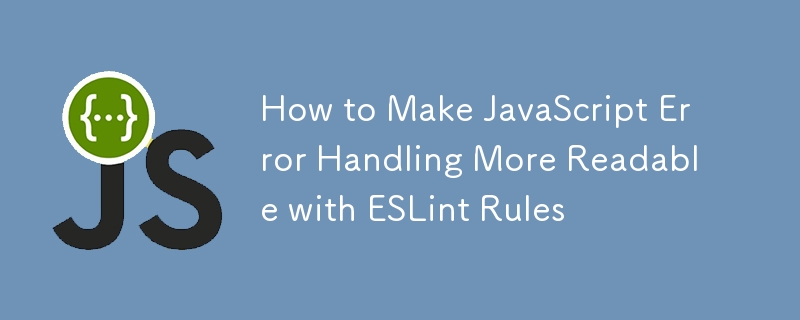

効果的なエラー処理は、堅牢な JavaScript アプリケーションにとって非常に重要です。これは、問題を迅速に特定し、デバッグを簡素化し、ソフトウェアの信頼性を高めるのに役立ちます。このガイドでは、ESLint による JavaScript エラー処理の改善について詳しく説明します。ESLint は、コードの品質を強化し、エラー処理方法を標準化するツールです。
読みやすいエラー処理により、問題に対する即座の洞察が得られ、開発者が問題を効率的に理解して修正できるようになります。この実践はチーム環境では不可欠であり、コードを長期的に維持するために不可欠です。
JavaScript エラー処理を強化するには、次の戦略を検討してください。
try {
const data = JSON.parse(response);
console.log(data);
} catch (error) {
console.error("Failed to parse response:", error);
}
class ValidationError extends Error {
constructor(message) {
super(message);
this.name = "ValidationError";
}
}
try {
throw new ValidationError("Invalid email address");
} catch (error) {
console.error(error.name, error.message);
}
function handleError(error) {
console.error(`${new Date().toISOString()} - Error: ${error.message}`);
}
投げるバージョン:
function calculateAge(dob) {
if (!dob) throw new Error("Date of birth is required");
}
非スローバージョン:
function tryCalculateAge(dob) {
if (!dob) {
console.error("Date of birth is required");
return null;
}
}
これらのプラクティスを強制するための ESLint のセットアップには、次の手順と構成が含まれます。
npm install eslint --save-dev npx eslint --init
効果的なエラー処理は、堅牢な JavaScript アプリケーションを開発するために不可欠です。以下は、コードベースで適切なエラー処理を強制するのに役立つ ESLint ルールです。
"promise/no-return-in-finally": "warn", "promise/always-return": "error"
"no-await-in-loop": "error"
// Incorrect
async function processArray(array) {
for (let item of array) {
await processItem(item);
}
}
// Correct
async function processArray(array) {
const promises = array.map(item => processItem(item));
await Promise.all(promises);
}
"promise/catch-or-return": "error", "async-await/space-after-async": "error"
"consistent-return": "error"
"no-unused-vars": ["error", {"args": "none"}],
"no-unused-catch-bindings": "error"
"no-throw-literal": "error"
// Incorrect
throw 'error';
// Correct
throw new Error('An error occurred');
"max-nested-callbacks": ["warn", 3]
"no-unused-expressions": ["error", {"allowShortCircuit": true, "allowTernary": true}]
"node/handle-callback-err": "error"
"no-console": "warn"
Ensure ESLint runs automatically before code commits or during CI/CD processes.
By adopting these ESLint rules and error-handling strategies, you elevate the readability and reliability of your JavaScript applications. These improvements facilitate debugging and ensure a smoother user experience.
Are you ready to transform your error handling approach? Implement these practices in your projects to see a significant boost in your development efficiency and code quality. Embrace these enhancements and lead your projects to success.
以上がESLint ルールを使用して JavaScript エラー処理を読みやすくする方法の詳細内容です。詳細については、PHP 中国語 Web サイトの他の関連記事を参照してください。